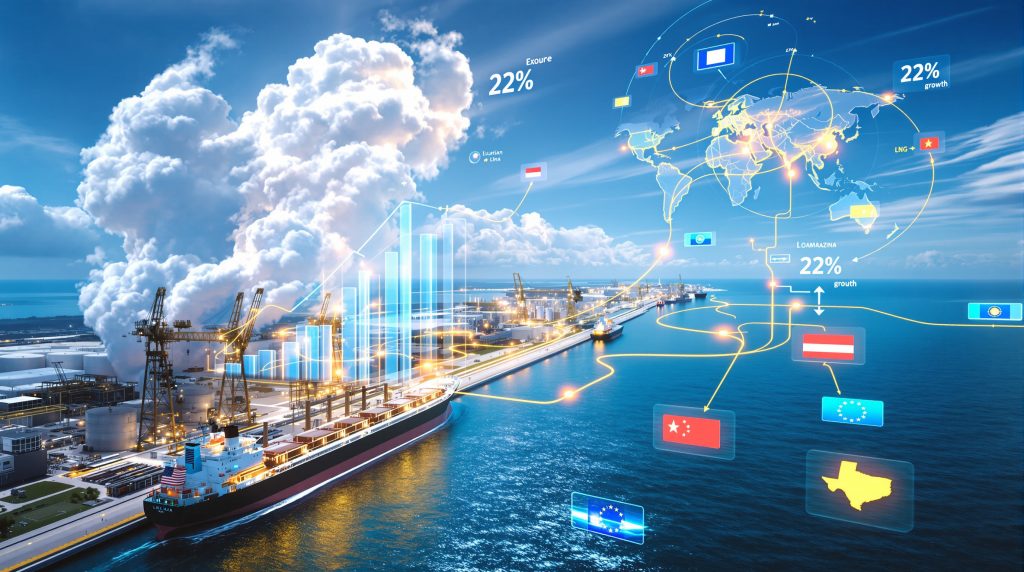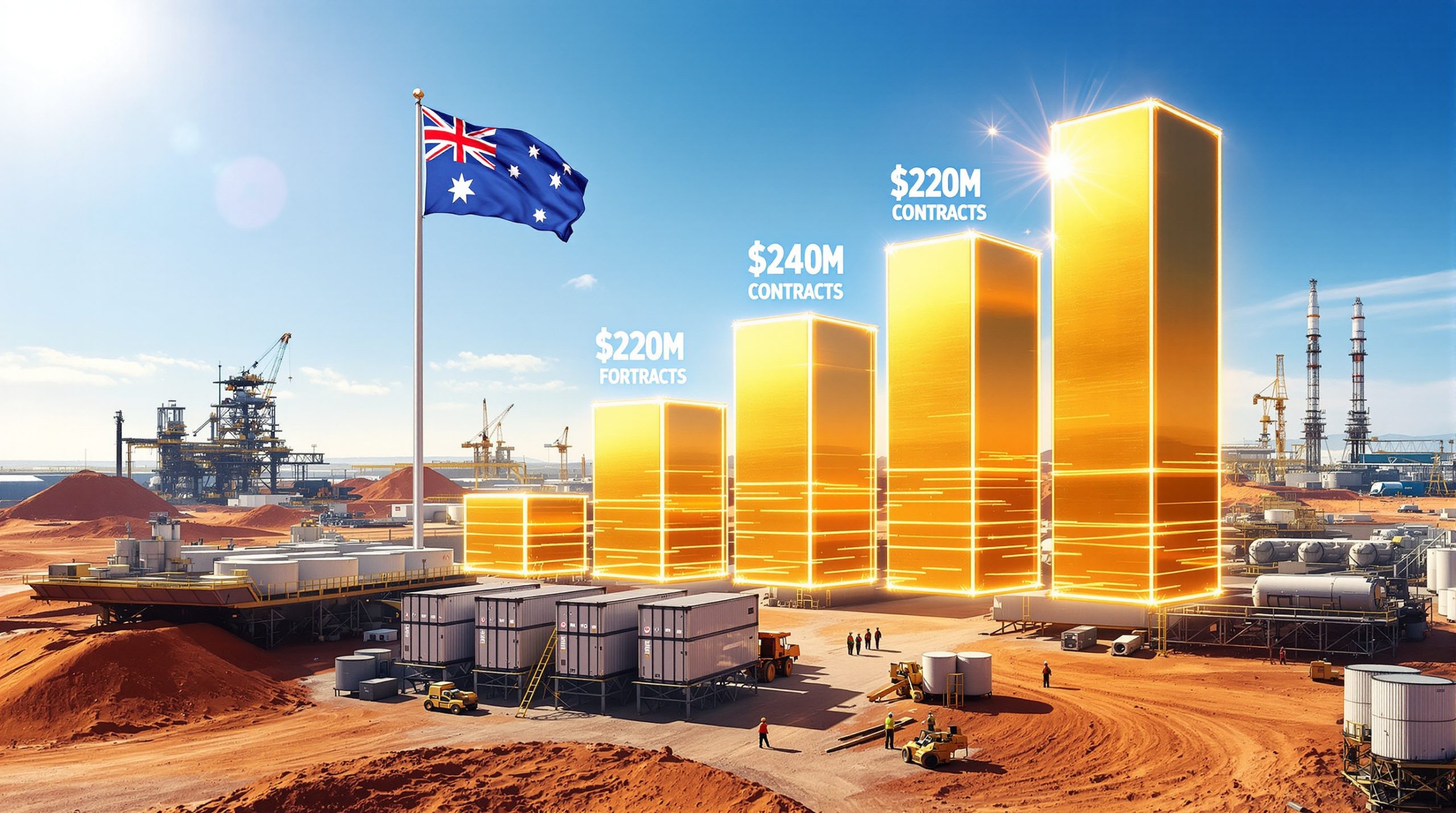Understanding America's Rise to LNG Export Dominance
The United States has completed one of the most dramatic energy transformations in modern history, evolving from a significant natural gas importer to commanding global liquefied natural gas markets within just fifteen years. This remarkable U.S. LNG export boom represents far more than a simple commodity trade reversal—it reflects fundamental changes in energy geopolitics, technological capabilities, and international supply chain dynamics.
The foundation of this transformation rests on the shale gas revolution, which unlocked vast domestic natural gas reserves previously considered uneconomical. Furthermore, combined with rapid development of liquefaction infrastructure along the Gulf Coast, America has positioned itself as the world's most flexible and responsive LNG supplier.
Record-Breaking Export Infrastructure and Capacity Growth
American LNG export capacity has expanded at unprecedented rates, with current infrastructure supporting approximately 11.9 billion cubic feet per day (Bcf/d) of liquefaction capacity as of 2024. However, the Energy Information Administration projects this figure will surge to 14.7 Bcf/d in 2025 and 16.3 Bcf/d by 2026, representing a 37% increase over two years.
| Year | Capacity (Bcf/d) | Growth Rate | Key Drivers |
|---|---|---|---|
| 2024 | 11.9 | Baseline | Existing facilities |
| 2025 | 14.7 | +23.5% | Plaquemines LNG startup |
| 2026 | 16.3 | +10.9% | Corpus Christi Stage 3 |
The geographic concentration of export facilities demonstrates strategic advantages in pipeline connectivity and industrial infrastructure. In addition, Gulf Coast terminals benefit from proximity to major shale gas production regions, existing petrochemical complexes, and deep-water ports capable of accommodating the largest LNG carriers.
Technical Infrastructure Details:
- Liquefaction Process: Natural gas cooled to -320°F (-160°C) for volume reduction of approximately 600:1
- Storage Capacity: Modern terminals maintain 3-7 days of production in cryogenic storage tanks
- Loading Systems: Specialised marine loading arms transfer LNG at rates up to 12,000 cubic metres per hour
- Regasification Requirements: Destination terminals must convert liquid LNG back to gaseous state for pipeline distribution
Near-term capacity additions of 5 Bcf/d across 2025-2026 will come primarily from two major projects: Plaquemines LNG and Corpus Christi Stage 3. These facilities represent different development strategies—Plaquemines as a greenfield project and Corpus Christi as an expansion of existing infrastructure.
European Energy Security Drives Unprecedented Demand
European market dynamics have fundamentally altered global LNG trade patterns, creating sustained demand for American exports that extends well beyond traditional spot market transactions. Consequently, the continent's strategic pivot away from pipeline gas dependence has resulted in long-term supply agreements that provide revenue stability for U.S. exporters.
This transformation reflects Europe's recognition that diversified supply sources enhance negotiating power with traditional suppliers. Moreover, American LNG offers operational flexibility that pipeline gas cannot match, allowing European buyers to adjust import volumes based on seasonal demand and economic conditions.
European LNG Infrastructure Expansion:
- Floating Storage Regasification Units (FSRUs): Rapid deployment capability for import capacity
- Pipeline Interconnections: Enhanced cross-border gas flow capacity within EU
- Storage Facilities: Strategic gas reserves for supply security during peak demand periods
The premium pricing European buyers accept for American LNG reflects the strategic value placed on supply diversification. Furthermore, these oil market dynamics increasingly influence contract structures that incorporate flexible delivery terms and seasonal pricing adjustments.
Asian Markets Embrace Strategic LNG Partnerships
Asian demand for U.S. LNG extends beyond pure energy requirements to encompass broader economic and diplomatic considerations. For instance, major importing nations view American gas purchases as components of comprehensive trade relationships that influence tariff negotiations and diplomatic cooperation.
China's approach exemplifies this strategic dimension, with LNG procurement decisions often coordinating with broader trade policy objectives. During periods of enhanced U.S.-China cooperation, Chinese companies have signed significant long-term supply agreements, whilst trade war oil impacts have correspondingly affected contract negotiations.
Asian Market Characteristics:
- Industrial Demand: Manufacturing sectors requiring consistent gas supply for production processes
- Power Generation: Natural gas-fired plants providing grid stability and backup power
- Seasonal Patterns: Winter heating demand creating predictable import volume fluctuations
- Economic Growth Correlation: LNG demand closely tracking industrial production and urbanisation rates
India's rapidly expanding LNG import requirements reflect the country's economic development trajectory and commitment to reducing coal dependence. In addition, Indian buyers have increasingly entered into medium-term contracts with American suppliers, providing demand stability whilst maintaining pricing flexibility.
Policy Framework Accelerates Development Timeline
The current U.S. administration's energy policies have created a regulatory environment that significantly expedites LNG project development through streamlined permitting processes. This represents a notable shift from previous approaches that included temporary review pauses and extended environmental assessments.
Regulatory clarity has enabled project developers to secure financing and proceed with construction activities on accelerated timelines. Furthermore, the elimination of lengthy approval processes for projects serving allies has particularly benefited facilities targeting European and Asian markets.
Policy Impact Areas:
- Federal Permitting: Expedited review processes for export authorisation
- Environmental Assessment: Streamlined evaluations focused on essential environmental protections
- International Trade: Coordination between energy policy and broader diplomatic objectives
- Infrastructure Development: Support for pipeline and port facility expansions
This policy environment has encouraged international energy companies to establish U.S. operations and invest in American LNG infrastructure. Consequently, foreign direct investment in U.S. LNG projects has increased substantially, bringing international expertise and capital to support rapid capacity expansion.
Project Investment Reaches Historic Levels
The year 2025 has witnessed unprecedented LNG project investment activity, with six major final investment decisions totaling $72 billion in global LNG finance—a record-breaking figure that demonstrates extraordinary confidence in long-term demand growth.
Major Project Approvals in 2025:
- Venture Global CP2 LNG Phase I: $15.1 billion project financing secured in July 2025
- NextDecade Rio Grande LNG Expansion: $6.7 billion facility development in Texas
- Sempra Port Arthur LNG Phase 2: $14 billion expansion approval
- Woodside Louisiana LNG: Production startup targeted for 2029
- Cheniere Corpus Christi Trains 8 & 9: Midscale expansion with debottlenecking capabilities
The financing success of these projects reflects investor confidence in long-term LNG demand growth and the competitive advantages of U.S. export facilities. Furthermore, international banks and investment funds have provided substantial capital, viewing American LNG projects as attractive long-term investments.
Contract momentum has reached exceptional levels, with American LNG developers securing sales and purchase agreements totalling 29.5 million metric tonnes per year in 2025—more than four times the volume contracted throughout 2024. This surge demonstrates strong buyer confidence and willingness to commit to long-term supply arrangements.
According to Poten & Partners business intelligence, this represents an unprecedented number of U.S. final investment decisions in a single year, surpassing the previous record of three projects. The achievement reflects coordinated efforts between project developers, financing institutions, and long-term customers to capitalise on favourable market conditions.
Rising Costs Meet Market Acceptance
Despite substantial cost escalation across the LNG project development sector, American exporters have successfully negotiated liquefaction fees approximately 15% higher than 2023 averages. Current fee discussions range from $2.65 to $2.95 per million British thermal units (MMBtu), compared to previous benchmarks around $2.00 per MMBtu.
Cost Escalation Factors:
- Raw Material Prices: Steel, concrete, and specialised equipment costs elevated by supply chain constraints
- Labour Market Tightness: Skilled construction workforce shortages in Gulf Coast regions
- Financing Costs: Higher interest rates increasing project capital requirements
- Regulatory Compliance: Enhanced environmental and safety standards requiring additional investment
- Tariff Policies: Import duties on construction materials affecting project economics
Jason Feer, head of business intelligence at Poten & Partners, noted that cost increases make it challenging for developers to maintain valid engineering contracts whilst advancing LNG export projects. However, buyer willingness to accept premium pricing has enabled developers to pass through increased costs.
Market Psychology Behind Premium Acceptance
Buyers in both European and Asian markets continue accepting higher costs, viewing premium pricing as acceptable for securing reliable American supply. This willingness reflects strategic considerations that extend beyond pure cost optimisation to encompass supply security and geopolitical risk mitigation.
The acceptance of higher fees demonstrates how energy security considerations now outweigh traditional cost minimisation strategies. Moreover, European buyers particularly view American LNG as essential for achieving complete independence from Russian gas supplies by 2027.
Future Capacity Growth and Market Dynamics
North American LNG export capacity is positioned to dominate global supply additions through the remainder of the decade. The United States and Qatar potentially control 80% of new global capacity additions by 2030, representing a fundamental shift in global gas market dynamics.
Capacity Development Timeline:
- 2025-2026: Plaquemines LNG and Corpus Christi Stage 3 adding 5 Bcf/d combined capacity
- 2027-2029: Multiple project completions potentially doubling current U.S. capacity
- Beyond 2030: Eleven additional projects holding full federal approval awaiting market conditions
The timeline assumes successful project execution and continued favourable market conditions. However, several factors could influence actual capacity additions, including construction challenges and evolving demand patterns in key importing regions.
Supply Chain Considerations:
- Pipeline Infrastructure: Capacity from production regions to export terminals must expand proportionally
- Workforce Development: Training programmes for specialised LNG facility operations and maintenance
- Port Infrastructure: Channel depths accommodating larger LNG carriers
- Storage Expansion: Strategic reserve capabilities for supply security and market stability
Industry analysts express concerns about potential supply oversupply by 2030, particularly when combined with Qatar's massive expansion projects scheduled for completion in 2027. Nevertheless, growing global demand from developing economies may absorb additional supply whilst supporting price stability.
What Factors Drive U.S. LNG Export Success?
The U.S. LNG export boom has fundamentally altered international energy relationships, providing importing nations with alternatives to traditional pipeline suppliers whilst creating new opportunities for energy diplomacy. This transformation extends far beyond commercial transactions to encompass strategic partnerships and geopolitical alignments.
American LNG exports have become tools of diplomatic engagement, enabling the United States to support allies through energy security partnerships. The flexibility of LNG shipping allows rapid response to supply disruptions, whilst oil price rally insights continue influencing market strategies.
Strategic Partnership Examples:
- European Union: Long-term supply agreements supporting energy independence goals
- Japan and South Korea: Enhanced bilateral relationships through energy cooperation
- India: Growing partnership encompassing energy, technology, and strategic cooperation
- Southeast Asia: Market development supporting regional economic growth
The ability to redirect LNG cargoes based on global market conditions provides the United States with unprecedented flexibility in energy diplomacy. Unlike pipeline gas, which flows through fixed infrastructure, LNG shipments can respond to emerging opportunities.
Climate Policy Implications
The rapid expansion of LNG export capacity raises important questions about long-term climate commitments and greenhouse gas emissions trajectories. Whilst natural gas burns cleaner than coal, increased production and export capacity could influence global decarbonisation timelines.
Environmental advocates continue monitoring methane leakage during production, processing, and transportation phases, emphasising the importance of advanced leak detection and mitigation technologies throughout the LNG supply chain.
Industry responses include investments in carbon capture technologies, methane emissions reduction programmes, and renewable energy integration at LNG facilities. Some project developers are incorporating sustainability metrics into contract terms, addressing environmental concerns whilst maintaining commercial competitiveness.
Regional Economic Impact and Investment Flows
The concentration of LNG infrastructure along the Gulf Coast has generated substantial economic benefits for Louisiana, Texas, and neighbouring states. This includes direct employment in construction and operations, indirect economic activity, and significant tax revenue generation for local communities.
Economic Multiplier Effects:
- Direct Employment: Construction workers, plant operators, and technical specialists
- Indirect Jobs: Transportation, logistics, and support service providers
- Induced Activity: Local spending supporting retail and service sectors
- Tax Revenue: Property taxes, sales taxes, and state revenue from energy operations
Louisiana has emerged as the dominant LNG export hub, hosting multiple major facilities and benefiting from existing petrochemical infrastructure. The state's experience with large-scale energy projects has facilitated rapid development whilst minimising regulatory challenges.
Texas represents the second-largest LNG export region, with facilities capitalising on the state's massive natural gas production and existing energy infrastructure. The combination of abundant gas supply, experienced workforce, and supportive regulatory environment has attracted billions in investment.
Trade Balance Contributions
LNG exports have become a major contributor to U.S. trade balance improvement, with energy exports helping offset traditional trade deficits in manufactured goods. This economic impact extends beyond direct energy sales to include associated services and technology exports.
The United States has leveraged its LNG export capabilities to strengthen trade relationships with key partners, often incorporating energy provisions into broader trade agreements. This approach demonstrates how energy exports can support broader economic and diplomatic objectives.
How Do Investment Strategies Support Market Growth?
The U.S. LNG export boom presents diverse investment opportunities across the energy value chain, from upstream natural gas production to downstream international marketing. Investment strategies have evolved to capture value at multiple points whilst managing risks associated with commodity price volatility.
Investment Categories:
- Integrated Producers: Companies controlling gas production, liquefaction, and international marketing
- Pure-Play Exporters: Specialised LNG facilities purchasing gas from third parties
- Infrastructure Developers: Pipeline, storage, and terminal facility construction and operation
- Shipping and Logistics: LNG carrier ownership and charter services
- Technology Providers: Advanced liquefaction equipment and process optimisation
Private equity and infrastructure funds have allocated substantial capital to LNG projects, attracted by long-term contracted revenue streams. The typical 15-20 year duration of LNG supply contracts provides revenue visibility that appeals to institutional investors.
Risk Management Considerations
Successful LNG investments require careful attention to commodity price risk, currency exposure, and regulatory changes in both exporting and importing countries. Many investors utilise hedging strategies and partnerships with experienced operators to manage these risks effectively.
The evolution of LNG contract structures has created opportunities for financial innovation, including floating pricing mechanisms and volume flexibility options. These contract features can enhance project returns whilst meeting buyer requirements, particularly as US oil production trends continue evolving.
Technical Innovation and Operational Excellence
The U.S. LNG industry has embraced technological advancement to improve operational efficiency, reduce environmental impact, and enhance safety performance. These innovations have contributed significantly to the competitiveness of American LNG in global markets.
Liquefaction Technology Advances:
- Modular Construction: Standardised equipment packages reducing construction time and costs
- Process Optimisation: Advanced control systems maximising throughput and energy efficiency
- Maintenance Innovation: Predictive maintenance programmes minimising downtime
- Digitalisation: Real-time monitoring and optimisation systems improving operational performance
American LNG facilities have achieved industry-leading availability rates through systematic application of advanced technologies and operational best practices. These performance improvements translate directly into competitive advantages where reliability commands premium pricing.
Environmental Technology Integration
The industry has invested heavily in emissions reduction technologies, including advanced leak detection systems and methane capture systems. These investments address regulatory requirements whilst supporting sustainability commitments from customers and investors.
Market Psychology and Long-Term Outlook
The psychological shift in global LNG markets reflects fundamental changes in how buyers and sellers view energy security, supply reliability, and strategic partnerships. Traditional cost optimisation approaches have evolved to incorporate broader considerations of geopolitical risk and supply chain resilience.
Buyer Behaviour Evolution:
- Portfolio Diversification: Multiple supply sources reducing concentration risk
- Strategic Partnerships: Long-term relationships beyond pure commercial transactions
- Flexibility Premium: Willingness to pay for operational and contractual flexibility
- Security Value: Recognition of energy security as worth premium pricing
This evolution in market psychology supports the sustainability of premium pricing for American LNG, even as global supply capacity expands through 2030. Buyers increasingly view supplier relationships as strategic partnerships that extend beyond commodity transactions.
The long-term outlook for U.S. LNG exports remains positive, supported by growing global demand and competitive production costs. However, success will depend on continued investment in technology, infrastructure, and operational excellence to maintain competitive advantages.
Emerging Market Opportunities
Developing economies represent significant growth opportunities for U.S. LNG exports, with countries across Africa, Latin America, and Southeast Asia seeking reliable energy supplies. These markets often prioritise supply security and flexible contract terms over pure cost minimisation.
The U.S. LNG export boom has established America as the world's swing supplier, capable of responding rapidly to global market changes whilst supporting allied energy security objectives. This position provides substantial economic benefits whilst enhancing American influence in global energy markets.
Furthermore, as US natural gas forecast models suggest continued abundance, the United States appears well-positioned to maintain leadership in global LNG markets through the remainder of the decade. The success of this transformation demonstrates how technological innovation, strategic policy frameworks, and market responsiveness can create lasting competitive advantages in global energy trade.
Ready to Capitalise on Energy Sector Opportunities?
Discovery Alert's proprietary Discovery IQ model delivers real-time alerts on significant energy and mineral discoveries across the ASX, instantly empowering subscribers to identify actionable opportunities ahead of the broader market. Begin your 30-day free trial today at Discovery Alert and secure your market-leading advantage in the evolving energy landscape.




